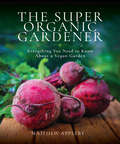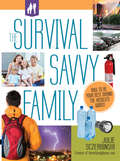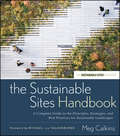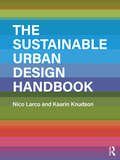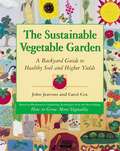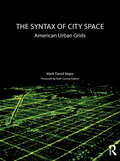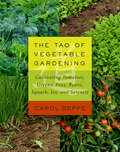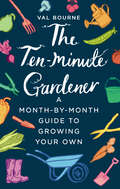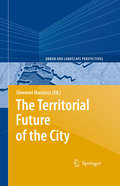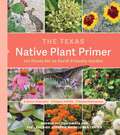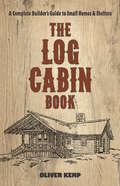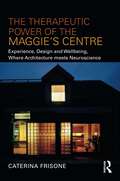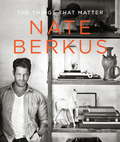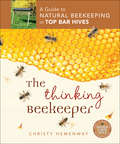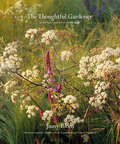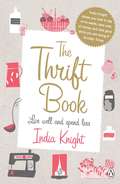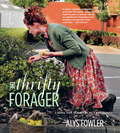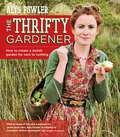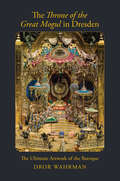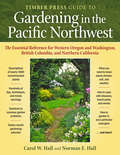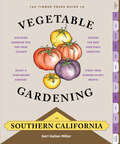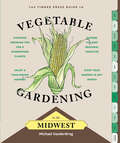- Table View
- List View
The Super Organic Gardener: Everything You Need to Know About a Vegan Garden
by Matthew ApplebyIf you care about what you eat, you should care about how you grow it.Gardeners can demonstrate that by going beyond organics to veganics - growing without animal inputs - they are a driving force in saving the environment.This book gives you the tools to grow without harming the planet and animals, and explains why moving beyond organics towards super organic vegan gardening is the way to show you are genuinely concerned about environmental issues and the industrial commodification of living, sentient creatures.From advice about how to make and buy natural fertilisers and compost, to putting nutritional values on what you grow, and to how to cook it, and how to share your plot with wildlife, this book covers all the bases.The foreword is by RHS Chelsea Flower Show best in show winner Cleve West, who is a passionate vegan gardener. Vegan Organic Network and Garden Organic have backed the book too.
The Super Organic Gardener: Everything You Need to Know About a Vegan Garden
by Matthew ApplebyIf you care about what you eat, you should care about how you grow it.Gardeners can demonstrate that by going beyond organics to veganics - growing without animal inputs - they are a driving force in saving the environment.This book gives you the tools to grow without harming the planet and animals, and explains why moving beyond organics towards super organic vegan gardening is the way to show you are genuinely concerned about environmental issues and the industrial commodification of living, sentient creatures.From advice about how to make and buy natural fertilisers and compost, to putting nutritional values on what you grow, and to how to cook it, and how to share your plot with wildlife, this book covers all the bases.The foreword is by RHS Chelsea Flower Show best in show winner Cleve West, who is a passionate vegan gardener. Vegan Organic Network and Garden Organic have backed the book too.
The Survival Savvy Family: How to Be Your Best During the Absolute Worst
by Julie SczerbinskiAuthor Julie Sczerbinski is just like you. She loves her family. And she worries about their well-being. Disasters, from natural to financial, concern her. But unlike most of us, she has a plan. And now, so can you. Smart, upbeat and direct, Survival Savvy Family helps you to be your best during the absolute worst. This thorough and handy book covers the basics--a family emergency plan, what to include in an emergency kit, tips on food and water storage--and the complex--natural disasters, house fires and home invasions. Find out how easy it is to plan for the unexpected without being overwhelmed. You can help your children stay safe at school, in the neighborhood and online. Learn to take control before chaos hits. Become a Survival Savvy Family.
The Sustainable Sites Handbook
by Meg CalkinsGet the definitive resource guide for sustainable site design, construction, and management. The Sustainable Sites Initiative (SITES) is transforming land design, development, and management practices across the United States with the first national rating system for sustainable landscapes. The Sustainable Sites Handbook features comprehensive and detailed information on principles, strategies, technologies, tools, and best practices for sustainable site design. Contributors to this book are some of the same experts that carefully shaped the SITES rating tool, ensuring thorough coverage of the broad range of topics related to sustainable site design. The Sustainable Sites Handbook offers in-depth coverage of design, construction, and management for systems of hydrology, vegetation, soils, materials, and human health and well-being. Focusing primarily on environmental site design and ecosystem services, this wide-ranging guide also covers issues of social equity, economic feasibility, and stewardship, which are crucial to the success of any sustainable site. Equally useful as a handbook for obtaining SITES credits or for the independent development of sustainable sites, The Sustainable Sites Handbook is an indispensible resource for practicing professionals in landscape architecture, landscape design, architecture, civil engineering, land planning, horticulture, ecology, environmental engineering, landscape contracting, and parks and recreation management.
The Sustainable Urban Design Handbook
by Nico Larco Kaarin KnudsonThe Sustainable Urban Design Handbook gathers the best sustainability practices and latest research from the fields of architecture, landscape architecture, planning, development, ecology, and environmental engineering and presents them in a graphically rich and accessible format that can help guide urban design decisions in cities of all sizes.The book presents a comprehensive framework that organizes more than 50 elements of sustainable urban design under five main topics–Energy Use & Greenhouse Gas, Water, Ecology & Habitat, Energy Use & Production, and Equity & Health–and relative to four project scales: Region & City, District & Neighborhood, Block & Street, and Project & Parcel. Each element chapter includes a summary of importance and background, compares typical practices and recommended approaches, explains connections to other elements, and concludes with urban design guidelines that can be used to directly inform projects and decisions.Easy to use and reference, The Sustainable Urban Design Handbook provides both an in-depth introduction to topics across sustainable urban design and serves as an on-going reference for anyone involved in the creation of sustainable urban environments. This resource will be useful to design and planning professionals, community members, students, and elected officials in guiding decisions about our sustainable future.
The Sustainable Vegetable Garden: A Backyard Guide to Healthy Soil and Higher Yields
by Carol Cox John JeavonsFrom the author of our best-selling and widely beloved HOW TO GROW MORE VEGETABLES comes this "quick and dirty" introduction to biointensive gardening that shows it is not only possible but easy to grow astonishing crops of healthful organic vegetables and fruits, while conserving resources and actually helping the soil. A revolutionary approach to feeding ourselves and nurturing the land, this book includes: Ģ Step-by-step illustrations and instructions that make these techniques simple for even the novice gardener. Ģ Everything you need to know about planning crops, composting, harvesting, and more. Ģ Complete resources for seeds, tools, and other garden supplies.Feed a family of four on the bounty of your backyard, or just get more out of your garden with less effort with this wonderful resource.From the Trade Paperback edition.
The Syntax of City Space: American Urban Grids
by Mark David MajorMany people see American cities as a radical departure in the history of town planning because of their planned nature based on the geometrical division of the land. However, other cities of the world also began as planned towns with geometric layouts so American cities are not unique. Why did the regular grid come to so pervasively characterize American urbanism? Are American cities really so different? The Syntax of City Space: American Urban Grids by Mark David Major with Foreword by Ruth Conroy Dalton (co-editor of Take One Building) answers these questions and much more by exploring the urban morphology of American cities. It argues American cities do represent a radical departure in the history of town planning while, simultaneously, still being subject to the same processes linking the street network and function found in other types of cities around the world. A historical preference for regularity in town planning had a profound influence on American urbanism, which endures to this day.
The Taming of the Screw
by Dave Barry Jerry O'BrienSeveral million homeowners' problems sidestepped
The Tao of Vegetable Gardening: Cultivating Tomatoes, Greens, Peas, Beans, Squash, Joy, and Serenity
by Carol DeppeThe Tao of Vegetable Gardening explores the practical methods as well as the deeper essence of gardening. In her latest book, groundbreaking garden writer Carol Deppe (The Resilient Gardener, Breed Your Own Vegetable Varieties) focuses on some of the most popular home garden vegetables—tomatoes, green beans, peas, and leafy greens—and through them illustrates the key principles and practices that gardeners need to know to successfully plant and grow just about any food crop.Deppe&’s work has long been inspired and informed by the philosophy and wisdom of Tao Te Ching, the 2,500-year-old work attributed to Chinese sage Lao Tzu and the most translated book in the world after the Bible. The Tao of Vegetable Gardening is organized into chapters that echo fundamental Taoist concepts: Balance, Flexibility, Honoring the Essential Nature (your own and that of your plants), Effortless Effort, Non-Doing, and even Non-Knowing. Yet the book also offers a wealth of specific and valuable garden advice on topics as diverse as:• The Eat-All Greens Garden, a labor- and space-efficient way to provide all the greens a family can eat, freeze, and dry—all on a tiny piece of land suitable for small-scale and urban gardeners.• The growing problem of late blight and the future of heirloom tomatoes—and what gardeners can do to avoid problems, and even create new resistant varieties.• Establishing a Do-It-Yourself Seed Bank, including information on preparing seeds for long-term storage and how to &“dehybridize&” hybrids.• Twenty-four good places to not plant a tree, and thirty-seven good reasons for not planting various vegetables.Designed for gardeners of all levels, from beginners to experienced growers, The Tao of Vegetable Gardening provides a unique frame of reference: a window to the world of nature, in the garden and in ourselves.
The Ten-Minute Gardener: A month-by-month guide to growing your own
by Val Bourne'Will delight every gardener' - BBC Gardener's WorldThe perfect book for those who garden in snatched moments from the Garden Media Guild Awards 2020 Journalist of the YearWhether you have a spacious plot or a small patch in the garden, this handbook is full of tried-and-tested tips from a seasoned old hand. It offers practical month-by-month suggestions for making the most of the little time you can spare on both the coldest winter days and the long summer afternoons, with ideas to inspire even the most experienced allotment gardeners. Focusing on the essentials needed to produce a great crop, this is for those who want to but struggle to find the time to grow their own.*Combined and updated editions of The Ten Minute Gardener's Fruit-Growing Diary and The Ten Minute Gardener's Vegetable-Growing Diary*
The Territorial Future of the City
by Giovanni MacioccoThe volume brings together contributions by leading scholars and young academics with experience in the urban potential of the territory in situations not necessarily linked to the dense metropolis, its compact form or to city sprawl. What brings these scholars together is their common reflection on this central theme, though from varied disciplinary and experimental backgrounds. They offer new forms of representing social and spatial processes of the contemporary society.
The Texas Native Plant Primer: 225 Plants for an Earth-Friendly Garden
by Lady Bird Johnson Wildflower Center Andrea DeLong-AmayaFrom Texas's leading native plant organization comes an accessible and colorful guide to planting native for home gardeners at every level of expertise. Do you want a garden that makes a real difference? Choose plants native to our Texas. The rewards will benefit you, your yard, and the environment—from reducing maintenance tasks to attracting earth-friendly pollinators such as native birds, butterflies, and bees. Native plant expert Andrea DeLong-Amaya and the world famous Lady Bird Johnson Wildflower Center make adding these superstar plants easier than ever before, with proven advice that every home gardener can follow. This incomparable sourcebook includes native ferns, grasses, wildflowers, perennials, vines, shrubs, and trees. It&’s everything you need to know to create a beautiful and beneficial garden.
The The Log Cabin Book: A Complete Builder's Guide to Small Homes and Shelters
by Oliver KempThis vintage guide from over a century ago offers timeless, practical advice on building log cabins. Plans and directions for simple structures are easy enough for amateurs to follow; time and inclination are the only necessary elements. Each of the designs has been tested and allows numberless alterations to suit the builder's tastes and requirements. Instructions range from selecting a site and safe, efficient methods of cutting down trees for building materials to building an ice house and boathouse to furnishing and decorating interiors. Photographs and drawings provide clear images for a variety of wilderness homes, including floor plans for The Block House, Wildwood, Crow's Nest, Idlewild, and other rustic retreats. Rich in nostalgic charm as well as useful applications, this manual offers priceless guidance to handymen, woodworkers, and hunters as well as those interested in small houses, construction, and home history and seekers of off-the-grid, environmentally friendly living.
The Therapeutic Power of the Maggie’s Centre: Experience, Design and Wellbeing, Where Architecture meets Neuroscience
by Caterina FrisoneThis book is about the therapeutic environment of the Maggie’s centre and explores the many ways this is achieved. With an unconventional architecture as required by the design brief, combined with Maggie’s psychological support programme, this special health facility allows extraordinary therapeutic effects in people, to the point that one can speak of therapeutic power.After tracing the story of the Maggie’s centre, the book reveals its fundamentals: Maggie’s Therapeutikos (the-mind-as-important-as-the-body), the Architectural Brief and the ‘Client-Architect-Users’ Triad. It continues by unfolding Maggie’s synergy-that between people and place-which increases users’ psychological flexibility helping them tolerate what was intolerable before. Although comfort and atmospheres are paramount, they are not enough to define the therapeutic environment of the Maggie’s centre. Only by looking at neuroscience that can give us scientific explanations of empathy, feelings and emotions and only considering space neither neutral nor empty, but full of forces that envelop people in an embodied experience, can we explain what generates wellbeing in a Maggie’s centre.The book concludes by critically evaluating the Maggie’s centre as a model to be applied to other healthcare facilities and to architecture in general. It is essential reading for any student or professional working on therapeutic environments.
The Things That Matter
by Nate BerkusDoes your home tell the story of who you are? In The Things That Matter, Nate Berkus shares intimate stories from his life, introduces us to people who influenced him and helped him forge his sense of style, and opens up about the remarkable experiences that have left him forever changed, all of which find expression in how he lives today. From his most cherished flea market finds, to his beloved books and photos, to the many extraordinary mementos he's collected in his travels, every piece defines who he's become and what endures in his world. Berkus invites readers into his own home as well as into twelve others, including a sleek steel-and-glass high-rise that soars above Chicago, a rustic cottage in the Hudson Valley, an ultra-chic atelier that maximizes every inch of space, a Greenwich Village townhouse that holds multiple art collections, and a study in meaningful minimalism in Marfa, Texas. The distinctive interiors beautifully displayed in this book offer revealing portraits of their owners' lives and the inspiring choices that have made them who they are today. The Things That Matter convincingly lays out Nate Berkus's philosophy that things do matter. Our homes tell our stories, they reflect the places we've been and the people we've loved along the way--and there can be no more beautiful design for living than that.From the Hardcover edition.
The Thinking Beekeeper: A Guide to Natural Beekeeping in Top Bar Hives (Mother Earth News Books for Wiser Living)
by Christy HemenwayA beginner&’s complete guide to keeping bees in top bar hives, and why. What&’s the buzz about the growing popularity of backyard beekeeping? Providing habitat for bees, pollinating your garden, and producing honey for your family are some of the compelling reasons for taking up this exciting hobby. But conventional beekeeping requires a significant investment and has a steep learning curve. The alternative? Consider beekeeping outside the box.The Thinking Beekeeper is the definitive do-it-yourself guide to natural beekeeping in top bar hives. Based on the concept of understanding and working with bees&’ natural systems as opposed to trying to subvert them, the advantages of this approach include:· Simplicity, sustainability, and cost-effectiveness · Increased safety due to less heavy lifting and hive manipulation · Chemical-free colonies and healthy hives Top bar hives can be located anywhere bees have access to forage, and they make ideal urban hives. Emphasizing the intimate connection between our food systems, bees, and the well-being of the planet, The Thinking Beekeeper will appeal to the new breed of beekeeper who is less focused on maximizing honey yield, and more on ensuring the viability of the bee population now and in the coming years.Mother Earth News Books for Wiser Living Recommendation&“You&’ll find information you need here that&’s not available anywhere else. Both you and your bees will benefit from Christy&’s approach, advice, and philosophy.&” —Kim Flottum, editor, Bee Culture Magazine&“A unique and exceptional resource for the beginning beekeeper.&” —Marty Hardison, top bar beekeeper, educator and international developmental beekeeping consultant
The Thoughtful Gardener: An Intelligent Approach to Garden Design
by Jinny Blom“A detailed and richly illustrated account of how one of the UK’s leading practitioners approaches the art of garden design.” —Gardens IllustratedProlific designer Jinny Blom embraces a wide variety of styles, from large garden spaces to formal walled gardens and contemporary installations. What defines her work is her skill with plants and her ability to create a garden that responds to the history of the site and the wider landscape. The gardens Jinny creates are as different as their owners and their locations.In this book, Jinny shares her insight into the creative process she has developed while designing more than 250 gardens around the world. The Thoughtful Gardener contains modern takes on traditional forms, and is split into six sections: seeing, understanding, structuring, harmonizing, rooting, and liberating.All of Jinny’s gardens share a commitment to beautiful craftsmanship and considered planting. Structure and detail are important, and receive close attention. The styles vary considerably—logical, calm, beautiful, romantic, naturalistic, formal, sometimes spare—but the principles remain firm. Jinny designs for the long term, with consideration for the environment; these gardens are built to last.Reflecting Jinny’s highly individual character, there is plenty of wit and quirkiness alongside the expert knowledge, and it will appeal to the widest audience of garden lovers. Thoughtful and beautiful, yet practical and informative, this book marries artistry with functionality.Praise for The Thoughtful Gardener“The most romantic, creative person in garden design I know.” —Piet Oudolf“Jinny’s genius is to marry a beautiful vision to an extraordinary empathy with the landscape into which that vision will fit, resulting in a pastoral harmony second to none.” —Victoria, Lady Getty“The Thoughtful Gardener, at once a lavishly illustrated coffee-table tome and a friendly hands-on primer, offers a glimpse into some of the most magical gardens in the world.” —Architectural Digest“Landscaper Jinny Blom’s long-awaited book is so beautiful that you will not want to rush it. As the title suggests, there is more to this than lovely photography: the pages of The Thoughtful Gardener will stop you in your tracks and make you think about the potential of gardens, in a way that has never struck you before.” —Gardenista
The Thrift Book: Live Well and Spend Less
by India KnightThe Thrift Book is a guide to how to live well while spending less by bestselling writer India Knight.Feeling poor because of the credit crunch? Feeling guilty because of global warming? Feeling like you'd like to tighten your belt, but aren't ready to embrace DIY macramé handbags? No need to panic. Put down the economy mince and buy this book instead - it's a blueprint for living beautifully, while saving money and easing your conscience. India Knight will show you:- How to make wonderful dinners with every little money- How to dress on a budget and still look fabulous- How to make friends and start sharing with your neighbours- How to holiday imaginatively - with barely a carbon footprintTry it - you have nothing to lose but your overdraft.'A blueprint for living well, however broke you are, with thrifty tips on looking fab, cooking, pampering and partying' Cosmopolitan'The Thrift Book might be the only sure-fire investment out there' Harper's Bazaar'A triumphant treat and a useful and sensible manual' IndependentIndia Knight is the author of four novels: My Life on a Plate, Don't You Want Me, Comfort and Joy and Mutton. Her non-fiction books include The Shops, the bestselling diet book Neris and India's Idiot-Proof Diet, the accompanying bestselling cookbook Neris and India's Idiot-Proof Diet Cookbook and The Thrift Book. India is a columnist for the Sunday Times and lives in London with her three children.Follow India on Twitter @indiaknight or on her blog at http://indiaknight.tumblr.com.
The Thrifty Forager: Living off your local landscape
by Alys FowlerAlys Fowler takes a fresh look at foraging, encouraging you to look closer to home, from the weeds in your garden to the trees in your street, rather than the fields and hedgerows of the countryside. Alys showcases her favourite edibles with a plant directory packed with useful information - photographic identification, plant description and tips on how to grow and how to eat it (including recipes such as fruit leathers and chutney) - that will give you the confidence to identify plants yourself. The book also features innovative ideas for eating your local landscape, from community gardens in Todmorden, UK to Edimental (edible ornamentals) gardens in Norway - this is a fast-growing, global phenomenon that is fun, environmentally friendly and thrifty!
The Thrifty Gardener: How To Create A Stylish Garden For Next To Nothing
by Alys FowlerForget makeover culture and all your gardening preconceptions, this is a witty, wise and practical take on to how to create a garden that suits you. The Thrifty Gardener is about creating the garden of your dreams, regardless of resources or limited space. It will eliminate the intimidation factor and reveal the ins-and-outs of soil, seeds, sowing and growing. At the heart of this book is a DIY ethic that says you don't always have to buy what you need, you can make it, take it or swap it with friends. From making window boxes out of wine cases to creating your own stylish compost bin, from bulking up perennials to finding plants for free, this book is packed with offbeat projects for a new generation of gardeners.
The Thrifty Gardener: How to create a stylish garden for next to nothing
by Alys FowlerForget makeover culture and all your gardening preconceptions, this is a witty, wise and practical take on to how to create a garden that suits you. The Thrifty Gardener is about creating the garden of your dreams, regardless of resources or limited space. It will eliminate the intimidation factor and reveal the ins-and-outs of soil, seeds, sowing and growing. At the heart of this book is a DIY ethic that says you don't always have to buy what you need, you can make it, take it or swap it with friends. From making window boxes out of wine cases to creating your own stylish compost bin, from bulking up perennials to finding plants for free, this book is packed with offbeat projects for a new generation of gardeners.
The Throne of the Great Mogul in Dresden: The Ultimate Artwork of the Baroque
by Dror WahrmanA masterful deciphering of an extraordinary art object, illuminating some of the biggest questions of the eighteenth century The Throne of the Great Mogul (1701–8) is a unique work of European decorative art: an intricate miniature of the court of the Mughal emperor Aurangzeb depicted during the emperor&’s birthday celebrations. It was created by the jeweler Johann Melchior Dinglinger in Dresden and purchased by the Saxon prince Augustus the Strong for an enormous sum. Constructed like a theatrical set made of gold, silver, thousands of gemstones, and amazing enamel work, it consists of 164 pieces that together tell a detailed story. Why did Dinglinger invest so much time and effort in making this piece? Why did Augustus, in the midst of a political and financial crisis, purchase it? And why did the jeweler secrete in it messages wholly unrelated to the prince or to the Great Mogul? In answering these questions, Dror Wahrman, while shifting scales from microhistory to global history, opens a window onto major historical themes of the period: the nature of European absolutism, the princely politics of the Holy Roman Empire, the changing meaning of art in the West, the surprising emergence of a cross-continental lexicon of rulership shared across the Eastern Hemisphere, and the enactment in jewels and gold of quirky contemporary theories about the global history of religion.
The Timber Press Guide to Gardening in the Pacific Northwest: The Essential Reference For Western Oregon And Washington, British Columbia, And Northern California
by Carol W. Hall Norman E. HallTired of being lumped into the unwieldy category of a western garden? Frustrated by the lack of reliable, practical information about gardening in the Pacific Northwest? No longer! The Timber Press Guide to Gardening in the Pacific Northwest presents all the information a gardener—whether novice or expert—needs to keep their garden beautiful and thriving. With a combined 100 years of gardening experience in the Pacific Northwest, the authors clearly explain the unique challenges and joys of gardening in the region. By dividing the Pacific Northwest into seven subregions, they help readers to better understand the climatic and geographical factors that shape their gardens. This complete guide includes extensive profiles of plants that are ideally suited to the region, including perennials, ornamental grasses, bulbs, groundcovers, roses, shrubs, trees, and climbers. The month-by-month gardening calendar describes what weather patterns to expect, what's in bloom, and what garden tasks are best done in that month. With additional chapters detailing the most common gardening problems and recommendations for effective, nontoxic ways of dealing with them, this book is nothing short of essential.
The Timber Press Guide to Vegetable Gardening in Southern California (Regional Vegetable Gardening Series)
by Geri Galian MillerGrow your own food in the Golden State! There is nothing more regionally specific than vegetable gardening—what to plant, when to plant it, and when to harvest are decisions based on climate, weather, and first frost. The Timber Press Guide to Vegetable Gardening in Southern California, by regional expert Geri Miller, focuses on the unique eccentricities of California’s gardening calendar, which include extreme temperatures and low rainfall. The month-by-month format makes it perfect for beginners and accessible to everyone—gardeners can start gardening the month they pick it up.
The Timber Press Guide to Vegetable Gardening in the Midwest (Regional Vegetable Gardening Series)
by Michael VanderBrugHow to grow your own food in the Heartland! There is nothing more regionally specific than vegetable gardening—what to plant, when to plant it, and when to harvest are decisions based on climate, weather, and first frost. The Timber Press Guide to Vegetable Gardening in the Midwest, by regional expert Michael VanderBrug, focuses on the unique eccentricities of the Midwest gardening calendar. The month-by-month format makes it perfect for beginners and accessible to everyone—gardeners can start gardening the month they pick it up. Perfect for home gardeners in Illinois, Indiana, Iowa, Kansas, Michigan, Minnesota, Missouri, Nebraska, North Dakota, Ohio, South Dakota, and Wisconsin.
